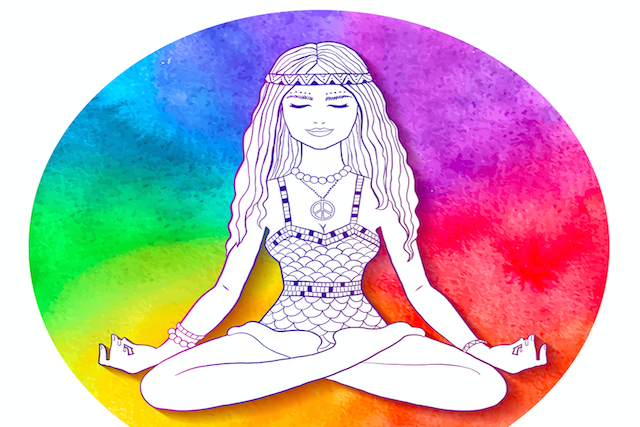
Have you ever found it hard to motivate yourself to do something that was good for you, only to eventually do it, feel amazing, and wonder why you waited so long?
That’s what meditating was like for me. Even though I knew I could do it for only five minutes each day to feel calmer, less stressed, and more present, I found excuses not to do it regularly for years.
I’d tell myself five minutes wasn’t enough; I really needed thirty or more, and I didn’t have that time, so why bother?
I’d lament that I was too anxious to sit still (ironic, considering that I knew meditating could calm my anxiety).
I’d complain that my environment was too distracting (irony yet again, since meditation ultimately helps us focus and better deal with distractions).
And then there was my most commonly used excuse: “It just doesn’t work for me.”
Of course it didn’t “work.” I wasn’t meditating with any consistency. And when I did, I got impatient with my own busy brain, like watching the proverbial pot that wouldn’t boil, instead of simply easing into the experience.
I was approaching it with a perfectionist mindset, as if I needed to eventually have a completely clear mind to be “good at it.”
Everything changed for me when I realized I could meditate in many different ways, to suit my schedule, moods, and needs; and that the only goal was to show up, mindfully observe my inner life, and practice detaching from my thoughts.
It was okay if I never achieved complete mental clarity. The practice itself, with its mental messiness and mind wandering, was the path to more clarity in my daily life.
And it’s not just about mental clarity. Adopting a regular meditation practice—even just five minutes a day—can improve your sleep, regulate your mood, boost your resilience, and help ease and prevent a number of physical ailments.
No other habit positively impacts so many areas of your life simultaneously. Because meditation helps reduce anxiety, depression, stress, and anger, while improving your focus, presence, and physical health, it bleeds into all areas of your life—your work, your relationships, your hobbies.
Literally everything can transform, over time, with just five minutes each day.
Whether you’re new to meditation or just looking for some alternative ways to fit mindfulness into your daily life, you may enjoy trying one or more of my favorite practices, including…
1. Alternate Nostril Breathing
Hold your left nostril down with your left thumb and inhale through your right nostril. Then close your right nostril with your left index finger, so both are closed, and hold the breath. Release your left nostril only and exhale.
With your right nostril still closed, inhale through your left. Now close your left nostril with your thumb, so both nostrils are closed, and hold the breath. Release your index finger from your right nostril and exhale.
This is one set. Complete a minimum of five sets to harmonize the left and right hemispheres of your brain, calm your nervous system, and create a sense of relaxation and ease.
2. The 100-Breaths Technique
Close your eyes. Feel your back against your chair and your feet pressed firmly on the ground, then gently bring yourself into the present moment. Now start breathing through your nostrils and counting as you go, thinking “and” for every inhale, and the number for each exhale—inhale “and,” exhale “one”; inhale “and,” exhale “two.”
Feel your belly rise with each inhalation and let the breaths slow as you count yourself into a greater sense of relaxation. After you reach 100, open your eyes, move your fingers and toes, and bow your head in gratitude for the mental space you created.
3. Full Body Breath Scan
Start by inhaling through your nose, expanding your stomach, and counting to five. As you breathe in, visualize soothing warm light filling your feet, and then exhale through your lips for a count of five, while visualizing yourself releasing any tension you may have been carrying there.
Repeat this process for your ankles, your shins, your knees, and so on, all the way up to your head. After you finish scanning your entire body, you’ll likely feel lighter, calmer, and more at ease.
4. Lip-Touching Breathing
When aroused, your sympathetic nervous system puts you in a state of high alert—that sense of “fight-or-flight” panic that tells you there’s some sort of threat. Your parasympathetic nervous system, when aroused, produces the opposite feeling—a sense of relaxation and ease.
In his book Buddha’s Brain, Rick Hanson suggests a few simple ways to stimulate the parasympathetic nervous system—the simplest of which is to touch your lip with two fingers.
The lips contain parasympathetic nerve fibers, making this is a simple approach to create a sense of calm that you can use anywhere, anytime. To reap the benefits, all you need to do is touch your lips, breathe slowly, and tell yourself, “I am safe.”
5. Walking Meditation
Though you can practice this any time you’re walking, you may want to find a peaceful place to stroll, in nature. If it’s safe to walk barefoot, this will give you a sense of being more connected to the earth.
Stand with your spine straight, with your shoulders and arms relaxed, and take a few inhalations and exhalations to breathe in calming energy and breathe out tension.
Now begin slowly moving forward and sync your breathing with your steps—right foot, inhale; left foot, exhale. Use all of your senses to fully experience where you are—the warm feeling of sun on your face, the soft sound of wind rustling leaves on trees. The goal is not to arrive at a destination; it’s simply to be present in the experience of walking.
6. Meditative Shower
It’s easy to let go of all other thoughts when you’re standing under a stream of water, set to the perfect temperature for you.
Take this time to tune into your senses. Choose a soap you love so that the scent is intoxicating. Enjoy the sensation of the water on your skin, and feel it drip down your back, your calves, and your heels.
Notice when you begin thinking about the day ahead (or behind you). Don’t judge the thoughts or yourself for having them. Instead, visualize them going down the drain and then bring your focus back to the experience of cleansing your body and mind.
(I’ve included a detailed guide on this very topic, titled How to Make Your Shower Mindful, Blissful, and Rejuvenating, in my new Mindfulness Kit, which you can find here!)
7. Chore Meditation
Whether you’re vacuuming, dusting, or washing dishes, it can be your meditation if you immerse yourself completely in the activity.
Washing dishes, for example, can be both satisfying and grounding. Feel the warm water on your hands; let yourself enjoy the experience of making something dirty clean again. Don’t think about finishing or what you’ll do when you’re done. Focus solely on the doing and see if you can find a sense of acceptance and presence in doing it slowly and well.
8. Mindful Eating
Instead of eating quickly with one eye on your food and the other on your iPhone, turn mealtime into meditation. It doesn’t take long to eat, so why not put everything aside and take this time for you? Your texts, emails, and social media pages will still be there when you’re done.
Breathe deeply and try to identify the different nuances of scent in each item on your plate. When you’re eating, take deep breaths between each bite, and think about your meal like a foodie, appreciating the different flavors and textures.
If you find your thoughts wandering to things you’ve done or have to do, bring your attention to the feeling of the fork in your hand. Then breathe deeply, take a bite, and focus on savoring the food in front of you.
—
You can incorporate any of these techniques into your day to begin to reap the benefits. And it really only takes five minutes, though you may be tempted to do more once you get started. Mindfulness just feels that good. In a world where it’s all too easy to get distracted and caught up in your thoughts and fears, there’s nothing quite as calming as a few moments of pure presence.
About Lori Deschene
Lori Deschene is the founder of Tiny Buddha. She started the site after struggling with depression, bulimia, c-PTSD, and toxic shame so she could recycle her former pain into something useful and inspire others to do the same. You can find her books, including Tiny Buddha’s Gratitude Journal and Tiny Buddha’s Worry Journal, here and learn more about her eCourse, Recreate Your Life Story, if you’re ready to transform your life and become the person you want to be.
- Web |
- More Posts












 Though I run this site, it is not mine. It's ours. It's not about me. It's about us. Your stories and your wisdom are just as meaningful as mine.
Though I run this site, it is not mine. It's ours. It's not about me. It's about us. Your stories and your wisdom are just as meaningful as mine. 